Applied Workplace Practice: Workplace Project Status Report BSMAN3193
VerifiedAdded on 2019/09/30
|19
|4954
|487
Report
AI Summary
This document presents a comprehensive workplace project status report, structured according to the provided template. The report includes sections on background, project status (covering progress, performance, issues, timeline, budget, and risk management), key deliverables, and conclusion with key reflections. The report emphasizes the importance of using APA referencing, incorporating active web links, and drawing upon academic literature to support findings. The assignment requires a word count between 1,500 and 1,800 words and includes guidelines for formatting, citation, and submission through Turnitin. The report highlights the need to reflect critically on the project's progress, linking experiences to academic theory and considering future improvements. The report's structure is designed to provide a detailed overview of project management practices, including elements such as Gantt charts, milestone planning, and budget analysis. The student is expected to provide a detailed account of the project, integrating supporting evidence to validate the position and to demonstrate learning from experience. The report is submitted by a student to Desklib to help other students.
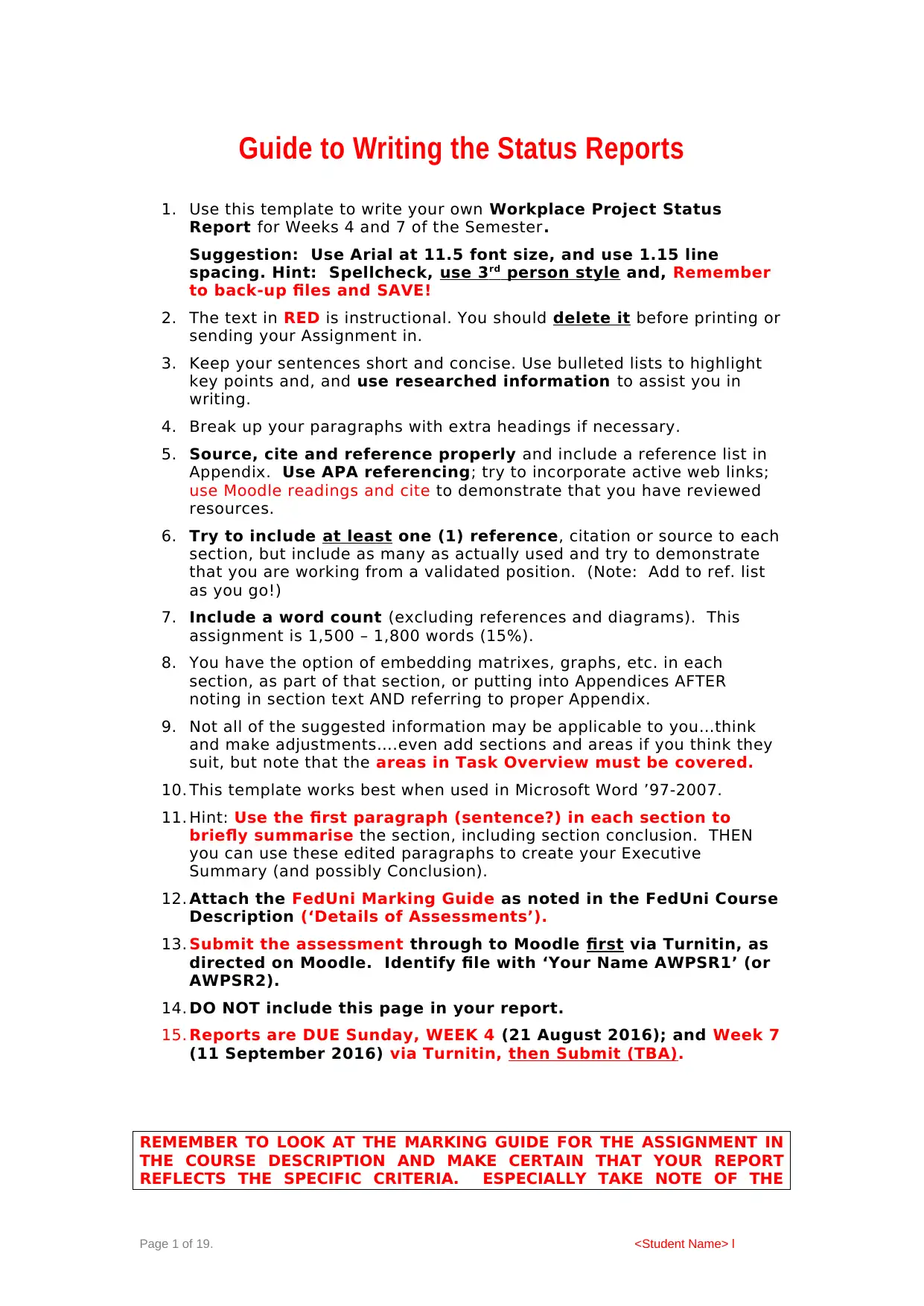
Guide to Writing the Status Reports
1. Use this template to write your own Workplace Project Status
Report for Weeks 4 and 7 of the Semester.
Suggestion: Use Arial at 11.5 font size, and use 1.15 line
spacing. Hint: Spellcheck, use 3rd person style and, Remember
to back-up files and SAVE!
2. The text in RED is instructional. You should delete it before printing or
sending your Assignment in.
3. Keep your sentences short and concise. Use bulleted lists to highlight
key points and, and use researched information to assist you in
writing.
4. Break up your paragraphs with extra headings if necessary.
5. Source, cite and reference properly and include a reference list in
Appendix. Use APA referencing; try to incorporate active web links;
use Moodle readings and cite to demonstrate that you have reviewed
resources.
6. Try to include at least one (1) reference, citation or source to each
section, but include as many as actually used and try to demonstrate
that you are working from a validated position. (Note: Add to ref. list
as you go!)
7. Include a word count (excluding references and diagrams). This
assignment is 1,500 – 1,800 words (15%).
8. You have the option of embedding matrixes, graphs, etc. in each
section, as part of that section, or putting into Appendices AFTER
noting in section text AND referring to proper Appendix.
9. Not all of the suggested information may be applicable to you…think
and make adjustments….even add sections and areas if you think they
suit, but note that the areas in Task Overview must be covered.
10. This template works best when used in Microsoft Word ’97-2007.
11. Hint: Use the first paragraph (sentence?) in each section to
briefly summarise the section, including section conclusion. THEN
you can use these edited paragraphs to create your Executive
Summary (and possibly Conclusion).
12. Attach the FedUni Marking Guide as noted in the FedUni Course
Description (‘Details of Assessments’).
13. Submit the assessment through to Moodle first via Turnitin, as
directed on Moodle. Identify file with ‘Your Name AWPSR1’ (or
AWPSR2).
14. DO NOT include this page in your report.
15. Reports are DUE Sunday, WEEK 4 (21 August 2016); and Week 7
(11 September 2016) via Turnitin, then Submit (TBA).
REMEMBER TO LOOK AT THE MARKING GUIDE FOR THE ASSIGNMENT IN
THE COURSE DESCRIPTION AND MAKE CERTAIN THAT YOUR REPORT
REFLECTS THE SPECIFIC CRITERIA. ESPECIALLY TAKE NOTE OF THE
Page 1 of 19. <Student Name> l
1. Use this template to write your own Workplace Project Status
Report for Weeks 4 and 7 of the Semester.
Suggestion: Use Arial at 11.5 font size, and use 1.15 line
spacing. Hint: Spellcheck, use 3rd person style and, Remember
to back-up files and SAVE!
2. The text in RED is instructional. You should delete it before printing or
sending your Assignment in.
3. Keep your sentences short and concise. Use bulleted lists to highlight
key points and, and use researched information to assist you in
writing.
4. Break up your paragraphs with extra headings if necessary.
5. Source, cite and reference properly and include a reference list in
Appendix. Use APA referencing; try to incorporate active web links;
use Moodle readings and cite to demonstrate that you have reviewed
resources.
6. Try to include at least one (1) reference, citation or source to each
section, but include as many as actually used and try to demonstrate
that you are working from a validated position. (Note: Add to ref. list
as you go!)
7. Include a word count (excluding references and diagrams). This
assignment is 1,500 – 1,800 words (15%).
8. You have the option of embedding matrixes, graphs, etc. in each
section, as part of that section, or putting into Appendices AFTER
noting in section text AND referring to proper Appendix.
9. Not all of the suggested information may be applicable to you…think
and make adjustments….even add sections and areas if you think they
suit, but note that the areas in Task Overview must be covered.
10. This template works best when used in Microsoft Word ’97-2007.
11. Hint: Use the first paragraph (sentence?) in each section to
briefly summarise the section, including section conclusion. THEN
you can use these edited paragraphs to create your Executive
Summary (and possibly Conclusion).
12. Attach the FedUni Marking Guide as noted in the FedUni Course
Description (‘Details of Assessments’).
13. Submit the assessment through to Moodle first via Turnitin, as
directed on Moodle. Identify file with ‘Your Name AWPSR1’ (or
AWPSR2).
14. DO NOT include this page in your report.
15. Reports are DUE Sunday, WEEK 4 (21 August 2016); and Week 7
(11 September 2016) via Turnitin, then Submit (TBA).
REMEMBER TO LOOK AT THE MARKING GUIDE FOR THE ASSIGNMENT IN
THE COURSE DESCRIPTION AND MAKE CERTAIN THAT YOUR REPORT
REFLECTS THE SPECIFIC CRITERIA. ESPECIALLY TAKE NOTE OF THE
Page 1 of 19. <Student Name> l
Paraphrase This Document
Need a fresh take? Get an instant paraphrase of this document with our AI Paraphraser
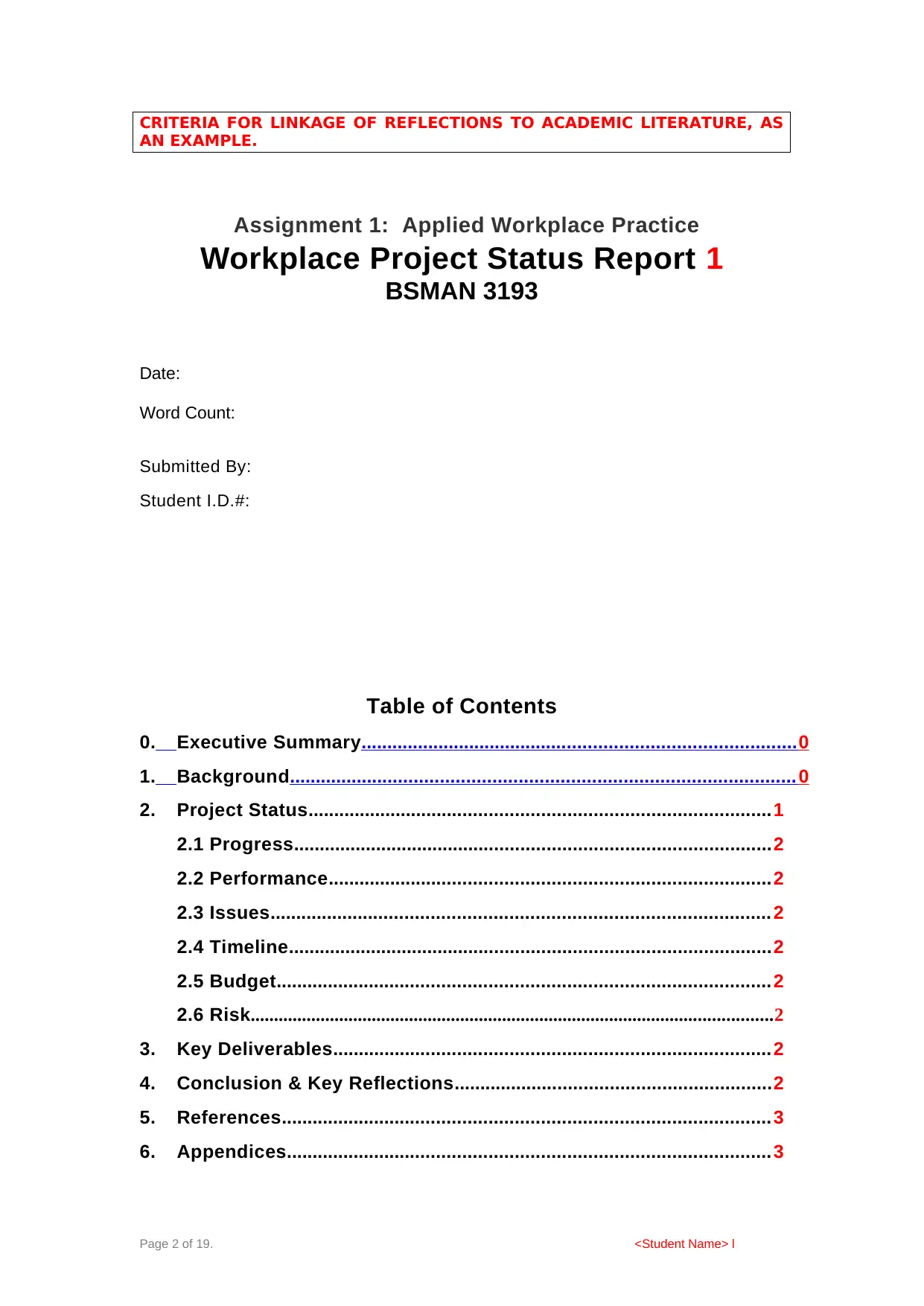
CRITERIA FOR LINKAGE OF REFLECTIONS TO ACADEMIC LITERATURE, AS
AN EXAMPLE.
Assignment 1: Applied Workplace Practice
Workplace Project Status Report 1
BSMAN 3193
Date:
Word Count:
Submitted By:
Student I.D.#:
Table of Contents
0. Executive Summary....................................................................................0
1. Background................................................................................................. 0
2. Project Status.........................................................................................1
2.1 Progress............................................................................................2
2.2 Performance.....................................................................................2
2.3 Issues................................................................................................ 2
2.4 Timeline.............................................................................................2
2.5 Budget...............................................................................................2
2.6 Risk................................................................................................................2
3. Key Deliverables....................................................................................2
4. Conclusion & Key Reflections.............................................................2
5. References..............................................................................................3
6. Appendices.............................................................................................3
Page 2 of 19. <Student Name> l
AN EXAMPLE.
Assignment 1: Applied Workplace Practice
Workplace Project Status Report 1
BSMAN 3193
Date:
Word Count:
Submitted By:
Student I.D.#:
Table of Contents
0. Executive Summary....................................................................................0
1. Background................................................................................................. 0
2. Project Status.........................................................................................1
2.1 Progress............................................................................................2
2.2 Performance.....................................................................................2
2.3 Issues................................................................................................ 2
2.4 Timeline.............................................................................................2
2.5 Budget...............................................................................................2
2.6 Risk................................................................................................................2
3. Key Deliverables....................................................................................2
4. Conclusion & Key Reflections.............................................................2
5. References..............................................................................................3
6. Appendices.............................................................................................3
Page 2 of 19. <Student Name> l
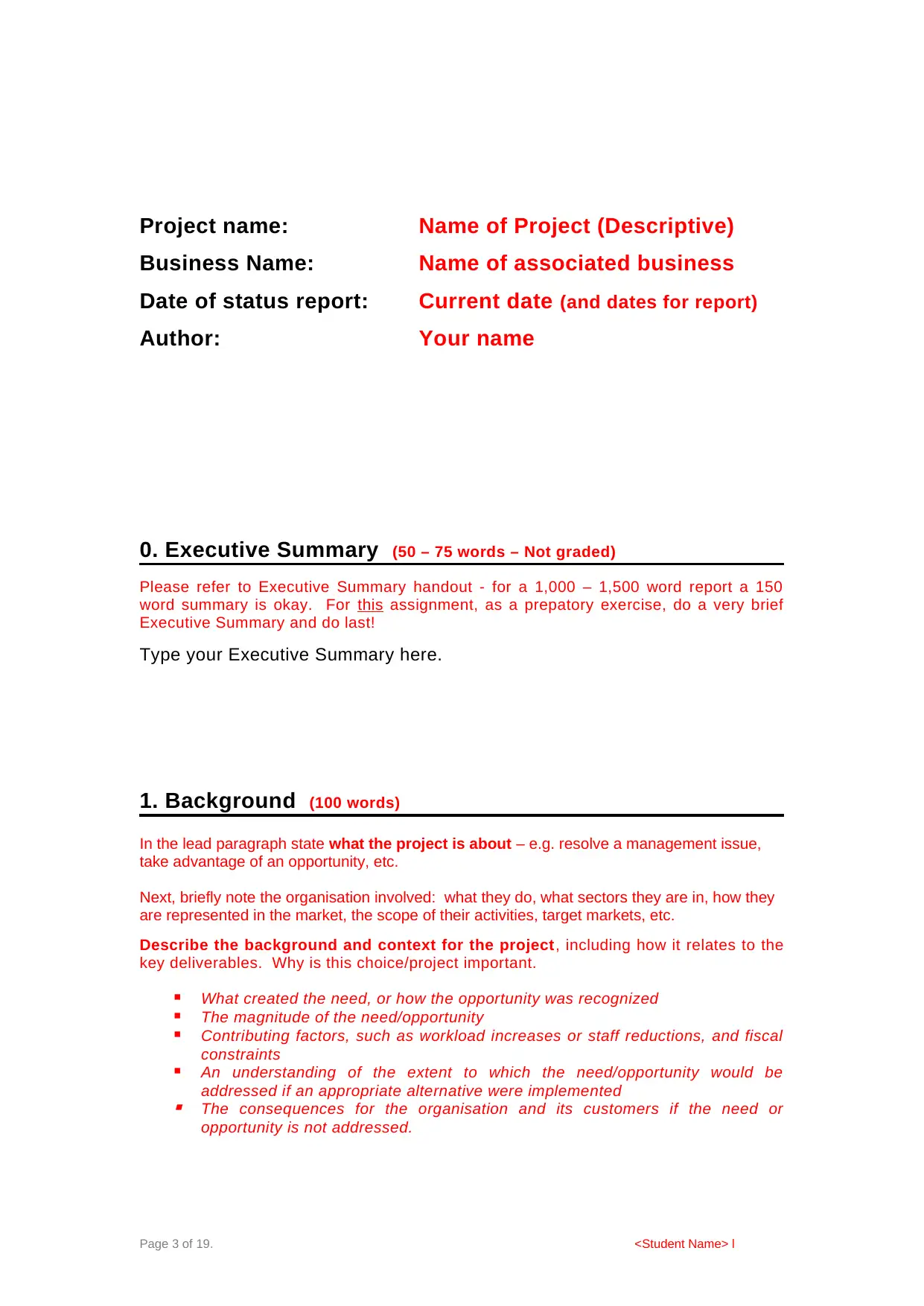
Project name: Name of Project (Descriptive)
Business Name: Name of associated business
Date of status report: Current date (and dates for report)
Author: Your name
0. Executive Summary (50 – 75 words – Not graded)
Please refer to Executive Summary handout - for a 1,000 – 1,500 word report a 150
word summary is okay. For this assignment, as a prepatory exercise, do a very brief
Executive Summary and do last!
Type your Executive Summary here.
1. Background (100 words)
In the lead paragraph state what the project is about – e.g. resolve a management issue,
take advantage of an opportunity, etc.
Next, briefly note the organisation involved: what they do, what sectors they are in, how they
are represented in the market, the scope of their activities, target markets, etc.
Describe the background and context for the project, including how it relates to the
key deliverables. Why is this choice/project important.
What created the need, or how the opportunity was recognized
The magnitude of the need/opportunity
Contributing factors, such as workload increases or staff reductions, and fiscal
constraints
An understanding of the extent to which the need/opportunity would be
addressed if an appropriate alternative were implemented
The consequences for the organisation and its customers if the need or
opportunity is not addressed.
Page 3 of 19. <Student Name> l
Business Name: Name of associated business
Date of status report: Current date (and dates for report)
Author: Your name
0. Executive Summary (50 – 75 words – Not graded)
Please refer to Executive Summary handout - for a 1,000 – 1,500 word report a 150
word summary is okay. For this assignment, as a prepatory exercise, do a very brief
Executive Summary and do last!
Type your Executive Summary here.
1. Background (100 words)
In the lead paragraph state what the project is about – e.g. resolve a management issue,
take advantage of an opportunity, etc.
Next, briefly note the organisation involved: what they do, what sectors they are in, how they
are represented in the market, the scope of their activities, target markets, etc.
Describe the background and context for the project, including how it relates to the
key deliverables. Why is this choice/project important.
What created the need, or how the opportunity was recognized
The magnitude of the need/opportunity
Contributing factors, such as workload increases or staff reductions, and fiscal
constraints
An understanding of the extent to which the need/opportunity would be
addressed if an appropriate alternative were implemented
The consequences for the organisation and its customers if the need or
opportunity is not addressed.
Page 3 of 19. <Student Name> l
⊘ This is a preview!⊘
Do you want full access?
Subscribe today to unlock all pages.

Trusted by 1+ million students worldwide

Type your Background here.
2. Project Status (450 words)
Detailed tatement of the to-date status of the project; the problem being addressed,
and what has occurred in the timeframe since its inception. Use some referencing to
support your situation.
You should include:
Scope: Describe in brief the functionality that is included within the project.
Synopsis of Project Limits and Exclusions
Project Assumptions Project Constraints Project Exclusions
Type here
2.1. Progress (50 words)
Detail the progress of the project to be assessed and/against any identified limitations.
Type here
2.2. Performance (50 words)
Detail the performance of the project and/against any initial assumptions.
Type here
Page 4 of 19. <Student Name> l
2. Project Status (450 words)
Detailed tatement of the to-date status of the project; the problem being addressed,
and what has occurred in the timeframe since its inception. Use some referencing to
support your situation.
You should include:
Scope: Describe in brief the functionality that is included within the project.
Synopsis of Project Limits and Exclusions
Project Assumptions Project Constraints Project Exclusions
Type here
2.1. Progress (50 words)
Detail the progress of the project to be assessed and/against any identified limitations.
Type here
2.2. Performance (50 words)
Detail the performance of the project and/against any initial assumptions.
Type here
Page 4 of 19. <Student Name> l
Paraphrase This Document
Need a fresh take? Get an instant paraphrase of this document with our AI Paraphraser
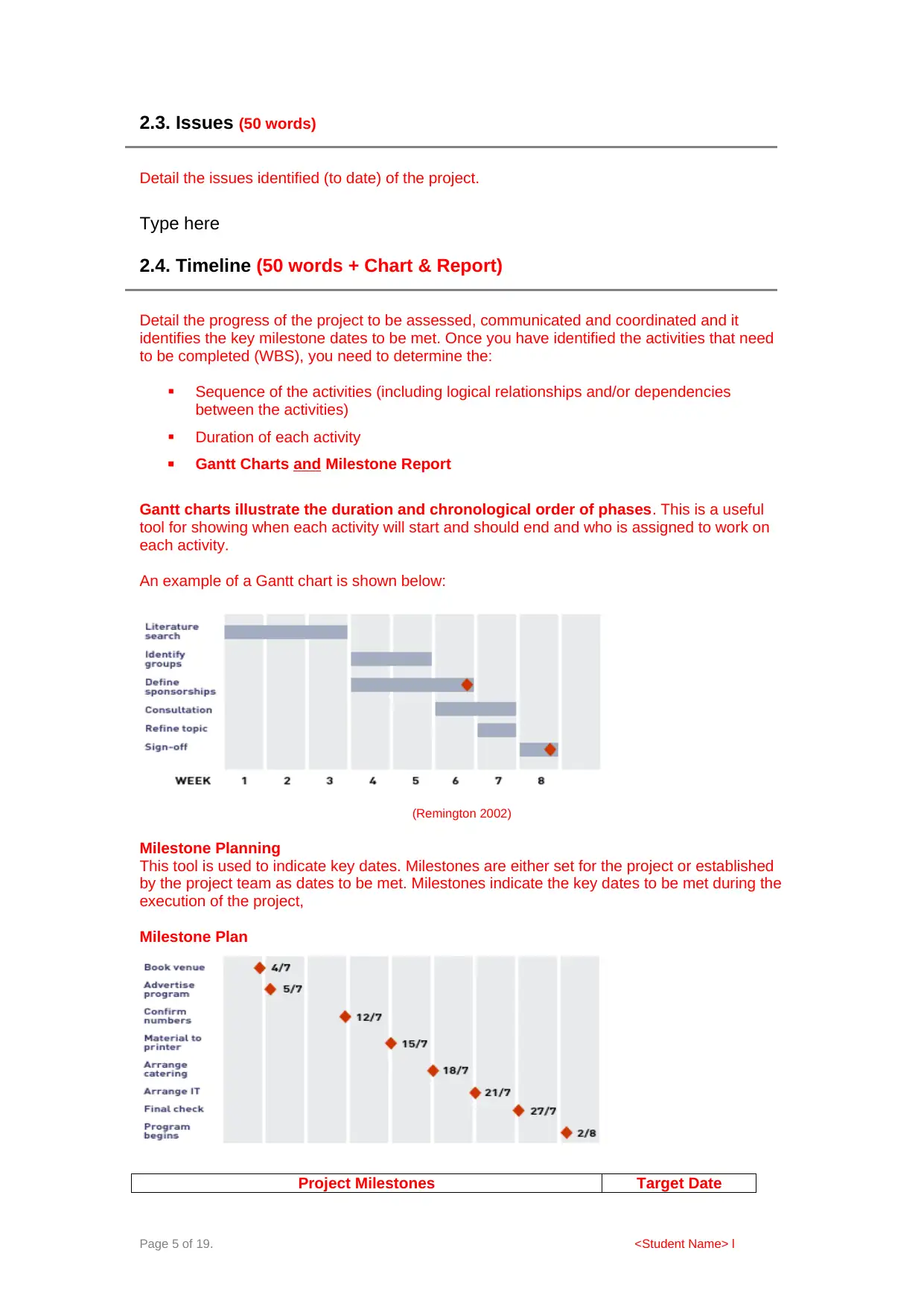
2.3. Issues (50 words)
Detail the issues identified (to date) of the project.
Type here
2.4. Timeline (50 words + Chart & Report)
Detail the progress of the project to be assessed, communicated and coordinated and it
identifies the key milestone dates to be met. Once you have identified the activities that need
to be completed (WBS), you need to determine the:
Sequence of the activities (including logical relationships and/or dependencies
between the activities)
Duration of each activity
Gantt Charts and Milestone Report
Gantt charts illustrate the duration and chronological order of phases. This is a useful
tool for showing when each activity will start and should end and who is assigned to work on
each activity.
An example of a Gantt chart is shown below:
(Remington 2002)
Milestone Planning
This tool is used to indicate key dates. Milestones are either set for the project or established
by the project team as dates to be met. Milestones indicate the key dates to be met during the
execution of the project,
Milestone Plan
Project Milestones Target Date
Page 5 of 19. <Student Name> l
Detail the issues identified (to date) of the project.
Type here
2.4. Timeline (50 words + Chart & Report)
Detail the progress of the project to be assessed, communicated and coordinated and it
identifies the key milestone dates to be met. Once you have identified the activities that need
to be completed (WBS), you need to determine the:
Sequence of the activities (including logical relationships and/or dependencies
between the activities)
Duration of each activity
Gantt Charts and Milestone Report
Gantt charts illustrate the duration and chronological order of phases. This is a useful
tool for showing when each activity will start and should end and who is assigned to work on
each activity.
An example of a Gantt chart is shown below:
(Remington 2002)
Milestone Planning
This tool is used to indicate key dates. Milestones are either set for the project or established
by the project team as dates to be met. Milestones indicate the key dates to be met during the
execution of the project,
Milestone Plan
Project Milestones Target Date
Page 5 of 19. <Student Name> l

Project Start <MM/DD/YY>
<Milestone> <MM/DD/YY>
<Milestone> <MM/DD/YY>
<Milestone> <MM/DD/YY>
<Milestone> <MM/DD/YY>
Project Completion <MM/DD/YY>
2.5 Budget (50 words)
Include a budget and a very short budget narrative. Remember the ‘phases’ of Initiation,
Planning, Execute & Control, Implementing and Close.
Budget
Line Item FY05-06/Baseline FY05-06/Adjusted
Labor Material Other FY Total Labor Material Other FY Total
Phase I
1. Initiate Project
1.1 Develop Project Charter $8,600 $0 $8,600 ($600) $8,000
2. Plan the Project
2.1 Develop Work Plan
2.2 Develop Project Control Plan $15,000 $0 $15,000 $15,000
2.3 Finalize Project Plan $5,000 0 $5,000 $5,000
3. Execute and Control Project
3.1 Design Framework $5,000 $0 $5,000 $5,000
3.2 Build Framework $65,000 $0 $2000 $67,000 $13,000 $80,000
3.3 Test the Framework $30,000 $0 $0 $30,000 $30,000
3.4 Implement the Framework $0 $0 $0 $0 $0
4. Close the Project $0 $0 $0 $0 $0
Total $128,600 $0 $2,000 $130,600 $12,400 $143,000
Total Revised Project Budget
$143,000
2.6. Risk Management Strategy (50 words + Chart/Table)
Project risks are characteristics, circumstances or features of the project environment that
may have an adverse effect on the project or the quality of the deliverables. Briefly detail key
risks. If you are so included, you can use a chart and matrix to highlight the strategy to
counter risks.
RISK EXPOSURE: KEY RISKS
R1. R2. Cost R3. Logistics R4. Workplace
Health & Safety
R5. Cultural
Implications
1. 1. 1) . 1. 1.
Page 6 of 19. <Student Name> l
<Milestone> <MM/DD/YY>
<Milestone> <MM/DD/YY>
<Milestone> <MM/DD/YY>
<Milestone> <MM/DD/YY>
Project Completion <MM/DD/YY>
2.5 Budget (50 words)
Include a budget and a very short budget narrative. Remember the ‘phases’ of Initiation,
Planning, Execute & Control, Implementing and Close.
Budget
Line Item FY05-06/Baseline FY05-06/Adjusted
Labor Material Other FY Total Labor Material Other FY Total
Phase I
1. Initiate Project
1.1 Develop Project Charter $8,600 $0 $8,600 ($600) $8,000
2. Plan the Project
2.1 Develop Work Plan
2.2 Develop Project Control Plan $15,000 $0 $15,000 $15,000
2.3 Finalize Project Plan $5,000 0 $5,000 $5,000
3. Execute and Control Project
3.1 Design Framework $5,000 $0 $5,000 $5,000
3.2 Build Framework $65,000 $0 $2000 $67,000 $13,000 $80,000
3.3 Test the Framework $30,000 $0 $0 $30,000 $30,000
3.4 Implement the Framework $0 $0 $0 $0 $0
4. Close the Project $0 $0 $0 $0 $0
Total $128,600 $0 $2,000 $130,600 $12,400 $143,000
Total Revised Project Budget
$143,000
2.6. Risk Management Strategy (50 words + Chart/Table)
Project risks are characteristics, circumstances or features of the project environment that
may have an adverse effect on the project or the quality of the deliverables. Briefly detail key
risks. If you are so included, you can use a chart and matrix to highlight the strategy to
counter risks.
RISK EXPOSURE: KEY RISKS
R1. R2. Cost R3. Logistics R4. Workplace
Health & Safety
R5. Cultural
Implications
1. 1. 1) . 1. 1.
Page 6 of 19. <Student Name> l
⊘ This is a preview!⊘
Do you want full access?
Subscribe today to unlock all pages.

Trusted by 1+ million students worldwide
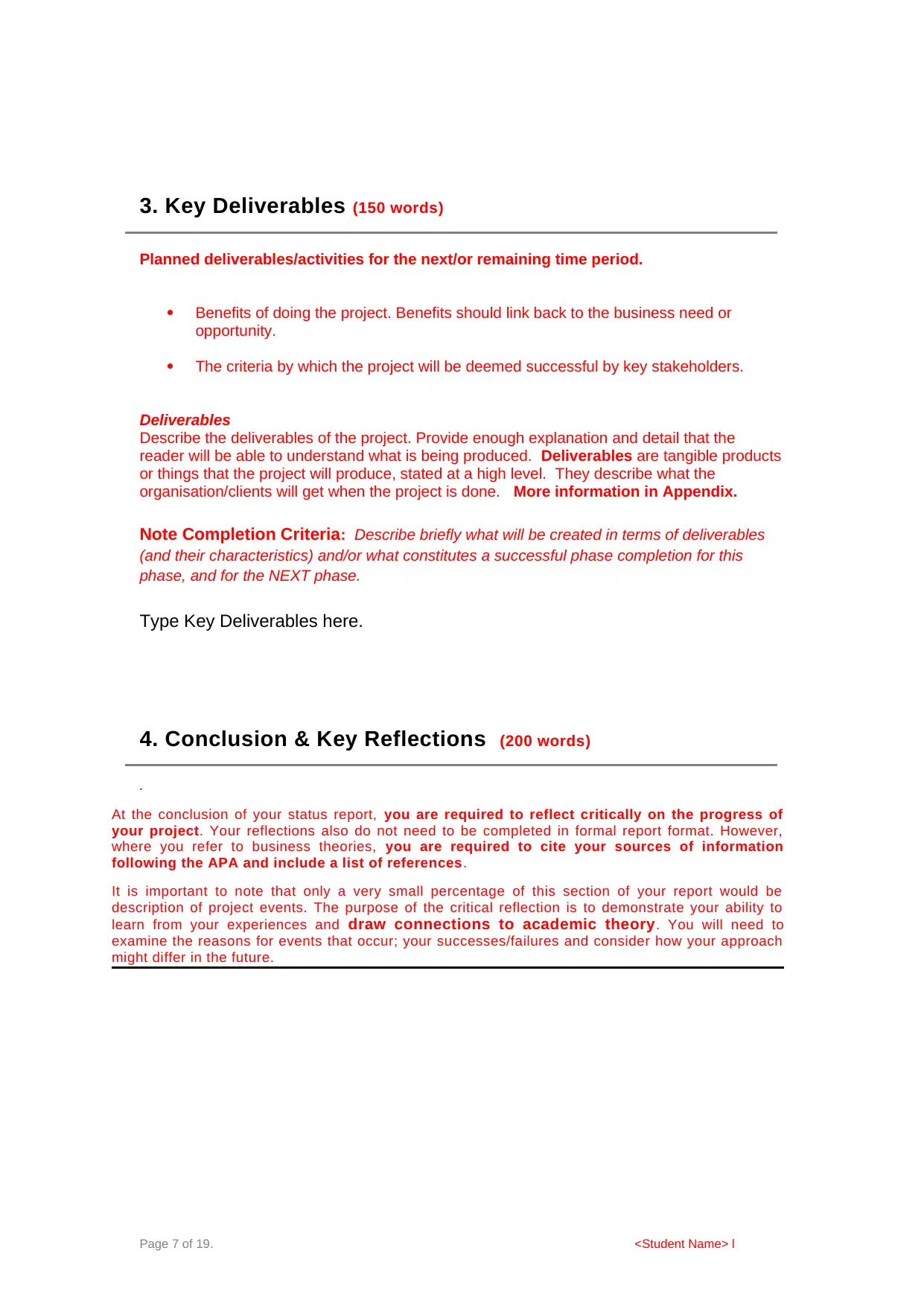
3. Key Deliverables (150 words)
Planned deliverables/activities for the next/or remaining time period.
Benefits of doing the project. Benefits should link back to the business need or
opportunity.
The criteria by which the project will be deemed successful by key stakeholders.
Deliverables
Describe the deliverables of the project. Provide enough explanation and detail that the
reader will be able to understand what is being produced. Deliverables are tangible products
or things that the project will produce, stated at a high level. They describe what the
organisation/clients will get when the project is done. More information in Appendix.
Note Completion Criteria: Describe briefly what will be created in terms of deliverables
(and their characteristics) and/or what constitutes a successful phase completion for this
phase, and for the NEXT phase.
Type Key Deliverables here.
4. Conclusion & Key Reflections (200 words)
.
At the conclusion of your status report, you are required to reflect critically on the progress of
your project. Your reflections also do not need to be completed in formal report format. However,
where you refer to business theories, you are required to cite your sources of information
following the APA and include a list of references.
It is important to note that only a very small percentage of this section of your report would be
description of project events. The purpose of the critical reflection is to demonstrate your ability to
learn from your experiences and draw connections to academic theory. You will need to
examine the reasons for events that occur; your successes/failures and consider how your approach
might differ in the future.
Page 7 of 19. <Student Name> l
Planned deliverables/activities for the next/or remaining time period.
Benefits of doing the project. Benefits should link back to the business need or
opportunity.
The criteria by which the project will be deemed successful by key stakeholders.
Deliverables
Describe the deliverables of the project. Provide enough explanation and detail that the
reader will be able to understand what is being produced. Deliverables are tangible products
or things that the project will produce, stated at a high level. They describe what the
organisation/clients will get when the project is done. More information in Appendix.
Note Completion Criteria: Describe briefly what will be created in terms of deliverables
(and their characteristics) and/or what constitutes a successful phase completion for this
phase, and for the NEXT phase.
Type Key Deliverables here.
4. Conclusion & Key Reflections (200 words)
.
At the conclusion of your status report, you are required to reflect critically on the progress of
your project. Your reflections also do not need to be completed in formal report format. However,
where you refer to business theories, you are required to cite your sources of information
following the APA and include a list of references.
It is important to note that only a very small percentage of this section of your report would be
description of project events. The purpose of the critical reflection is to demonstrate your ability to
learn from your experiences and draw connections to academic theory. You will need to
examine the reasons for events that occur; your successes/failures and consider how your approach
might differ in the future.
Page 7 of 19. <Student Name> l
Paraphrase This Document
Need a fresh take? Get an instant paraphrase of this document with our AI Paraphraser
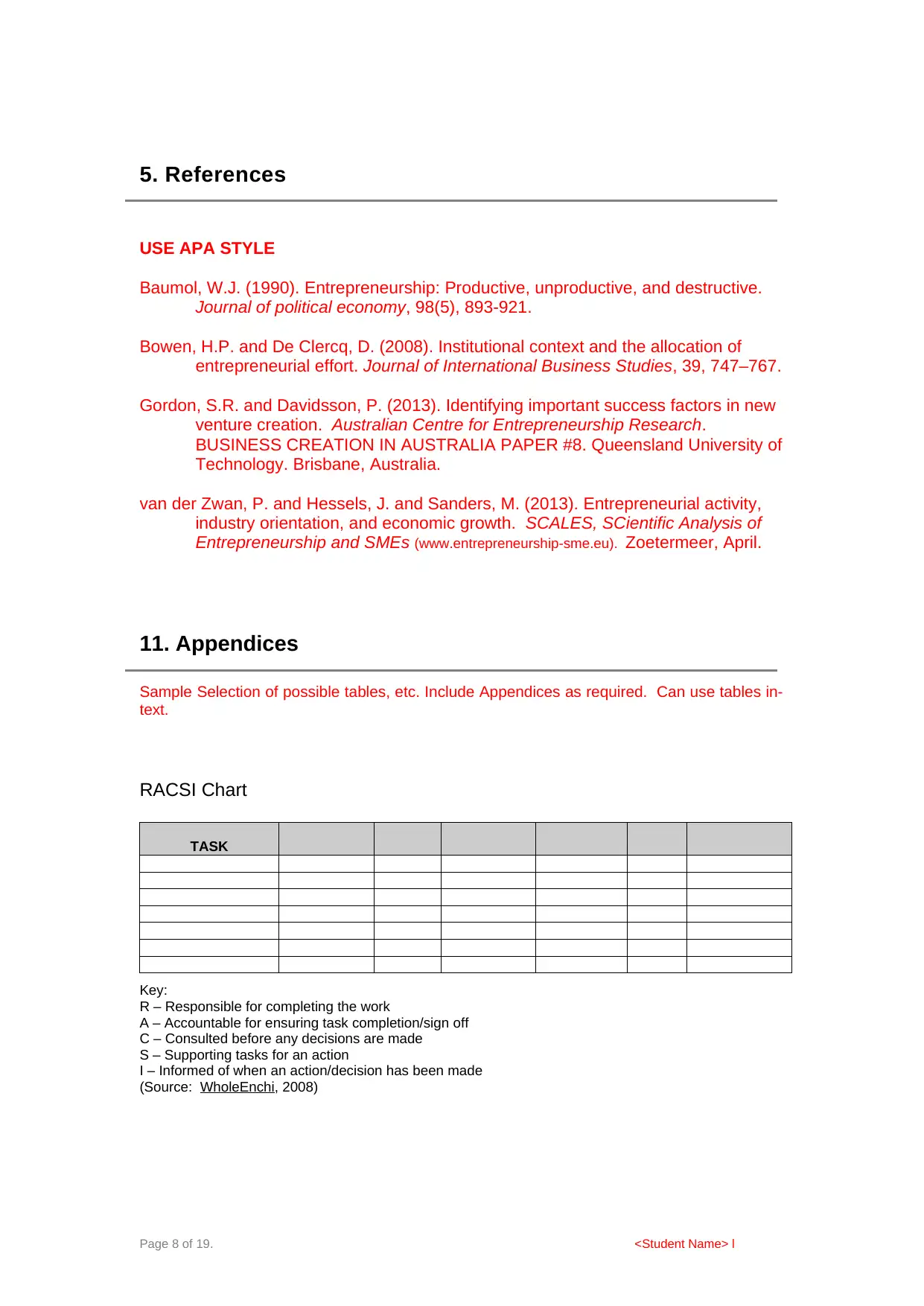
5. References
USE APA STYLE
Baumol, W.J. (1990). Entrepreneurship: Productive, unproductive, and destructive.
Journal of political economy, 98(5), 893-921.
Bowen, H.P. and De Clercq, D. (2008). Institutional context and the allocation of
entrepreneurial effort. Journal of International Business Studies, 39, 747–767.
Gordon, S.R. and Davidsson, P. (2013). Identifying important success factors in new
venture creation. Australian Centre for Entrepreneurship Research.
BUSINESS CREATION IN AUSTRALIA PAPER #8. Queensland University of
Technology. Brisbane, Australia.
van der Zwan, P. and Hessels, J. and Sanders, M. (2013). Entrepreneurial activity,
industry orientation, and economic growth. SCALES, SCientific Analysis of
Entrepreneurship and SMEs (www.entrepreneurship-sme.eu). Zoetermeer, April.
11. Appendices
Sample Selection of possible tables, etc. Include Appendices as required. Can use tables in-
text.
RACSI Chart
TASK
Key:
R – Responsible for completing the work
A – Accountable for ensuring task completion/sign off
C – Consulted before any decisions are made
S – Supporting tasks for an action
I – Informed of when an action/decision has been made
(Source: WholeEnchi, 2008)
Page 8 of 19. <Student Name> l
USE APA STYLE
Baumol, W.J. (1990). Entrepreneurship: Productive, unproductive, and destructive.
Journal of political economy, 98(5), 893-921.
Bowen, H.P. and De Clercq, D. (2008). Institutional context and the allocation of
entrepreneurial effort. Journal of International Business Studies, 39, 747–767.
Gordon, S.R. and Davidsson, P. (2013). Identifying important success factors in new
venture creation. Australian Centre for Entrepreneurship Research.
BUSINESS CREATION IN AUSTRALIA PAPER #8. Queensland University of
Technology. Brisbane, Australia.
van der Zwan, P. and Hessels, J. and Sanders, M. (2013). Entrepreneurial activity,
industry orientation, and economic growth. SCALES, SCientific Analysis of
Entrepreneurship and SMEs (www.entrepreneurship-sme.eu). Zoetermeer, April.
11. Appendices
Sample Selection of possible tables, etc. Include Appendices as required. Can use tables in-
text.
RACSI Chart
TASK
Key:
R – Responsible for completing the work
A – Accountable for ensuring task completion/sign off
C – Consulted before any decisions are made
S – Supporting tasks for an action
I – Informed of when an action/decision has been made
(Source: WholeEnchi, 2008)
Page 8 of 19. <Student Name> l
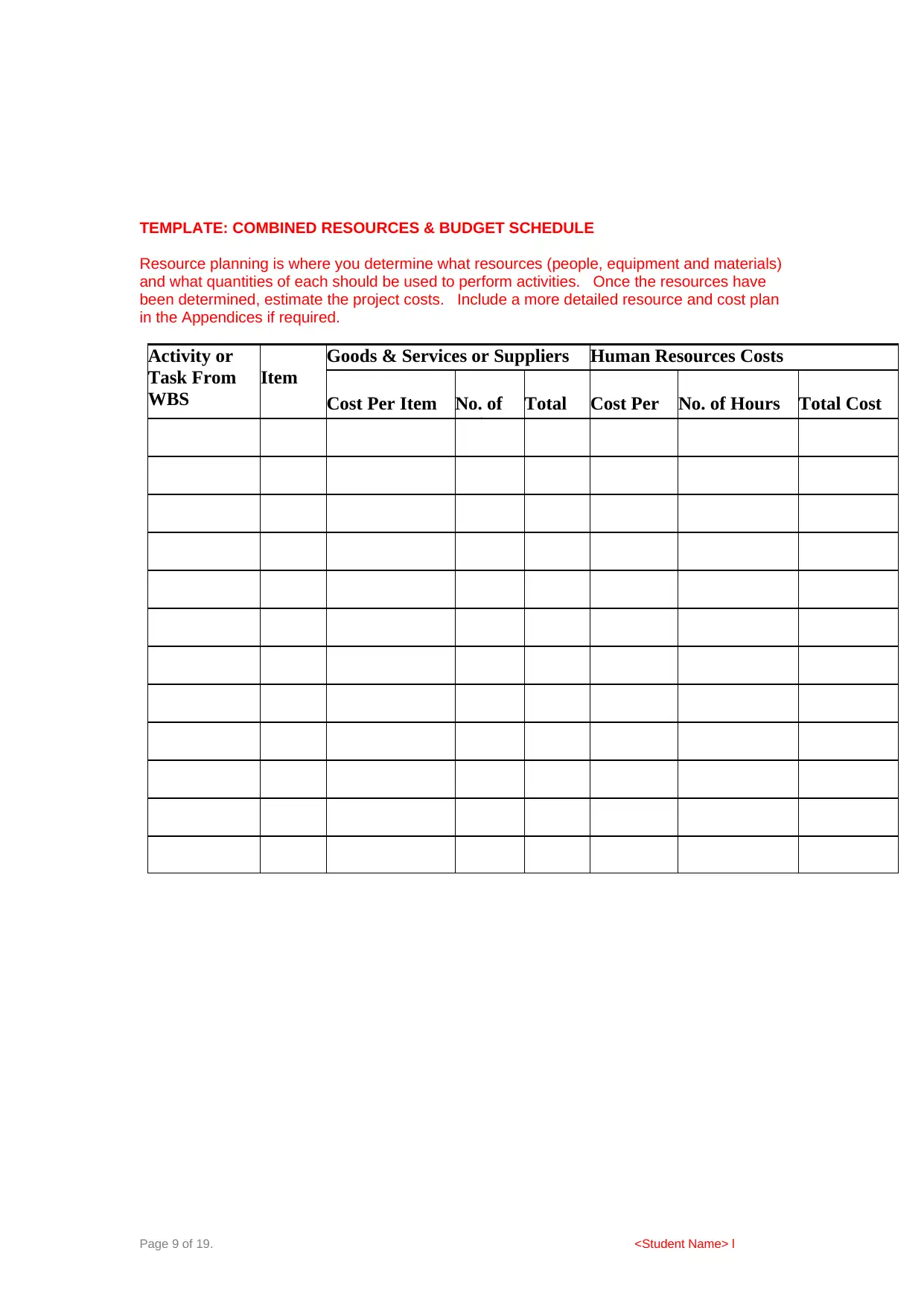
TEMPLATE: COMBINED RESOURCES & BUDGET SCHEDULE
Resource planning is where you determine what resources (people, equipment and materials)
and what quantities of each should be used to perform activities. Once the resources have
been determined, estimate the project costs. Include a more detailed resource and cost plan
in the Appendices if required.
Activity or
Task From
WBS
Item
Goods & Services or Suppliers
Costs
Human Resources Costs
Cost Per Item No. of
Units
Total
Cost
Cost Per
Hour
No. of Hours Total Cost
Page 9 of 19. <Student Name> l
Resource planning is where you determine what resources (people, equipment and materials)
and what quantities of each should be used to perform activities. Once the resources have
been determined, estimate the project costs. Include a more detailed resource and cost plan
in the Appendices if required.
Activity or
Task From
WBS
Item
Goods & Services or Suppliers
Costs
Human Resources Costs
Cost Per Item No. of
Units
Total
Cost
Cost Per
Hour
No. of Hours Total Cost
Page 9 of 19. <Student Name> l
⊘ This is a preview!⊘
Do you want full access?
Subscribe today to unlock all pages.

Trusted by 1+ million students worldwide
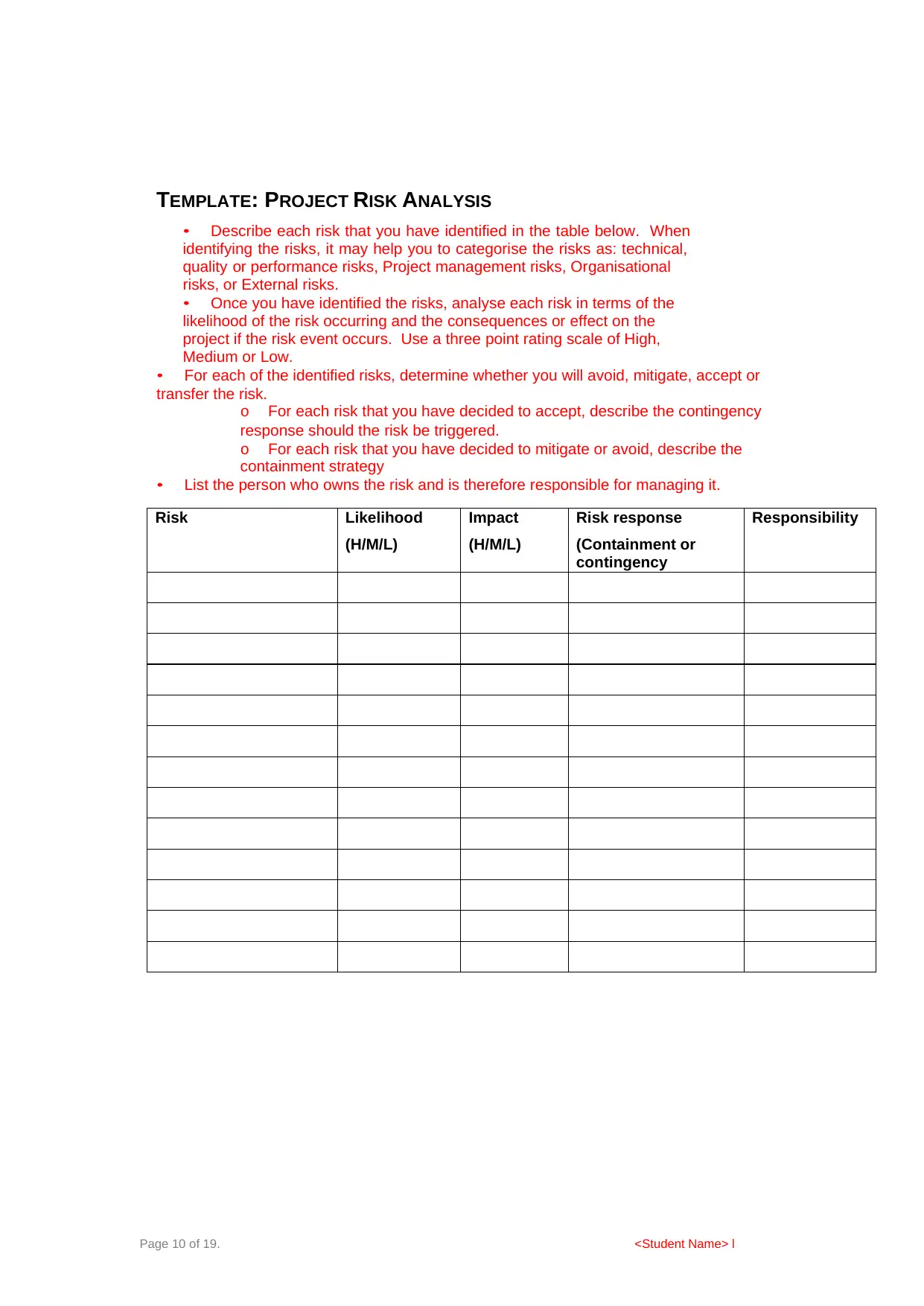
TEMPLATE: PROJECT RISK ANALYSIS
• Describe each risk that you have identified in the table below. When
identifying the risks, it may help you to categorise the risks as: technical,
quality or performance risks, Project management risks, Organisational
risks, or External risks.
• Once you have identified the risks, analyse each risk in terms of the
likelihood of the risk occurring and the consequences or effect on the
project if the risk event occurs. Use a three point rating scale of High,
Medium or Low.
• For each of the identified risks, determine whether you will avoid, mitigate, accept or
transfer the risk.
o For each risk that you have decided to accept, describe the contingency
response should the risk be triggered.
o For each risk that you have decided to mitigate or avoid, describe the
containment strategy
• List the person who owns the risk and is therefore responsible for managing it.
Risk Likelihood
(H/M/L)
Impact
(H/M/L)
Risk response
(Containment or
contingency
strategies)
Responsibility
Page 10 of 19. <Student Name> l
• Describe each risk that you have identified in the table below. When
identifying the risks, it may help you to categorise the risks as: technical,
quality or performance risks, Project management risks, Organisational
risks, or External risks.
• Once you have identified the risks, analyse each risk in terms of the
likelihood of the risk occurring and the consequences or effect on the
project if the risk event occurs. Use a three point rating scale of High,
Medium or Low.
• For each of the identified risks, determine whether you will avoid, mitigate, accept or
transfer the risk.
o For each risk that you have decided to accept, describe the contingency
response should the risk be triggered.
o For each risk that you have decided to mitigate or avoid, describe the
containment strategy
• List the person who owns the risk and is therefore responsible for managing it.
Risk Likelihood
(H/M/L)
Impact
(H/M/L)
Risk response
(Containment or
contingency
strategies)
Responsibility
Page 10 of 19. <Student Name> l
Paraphrase This Document
Need a fresh take? Get an instant paraphrase of this document with our AI Paraphraser
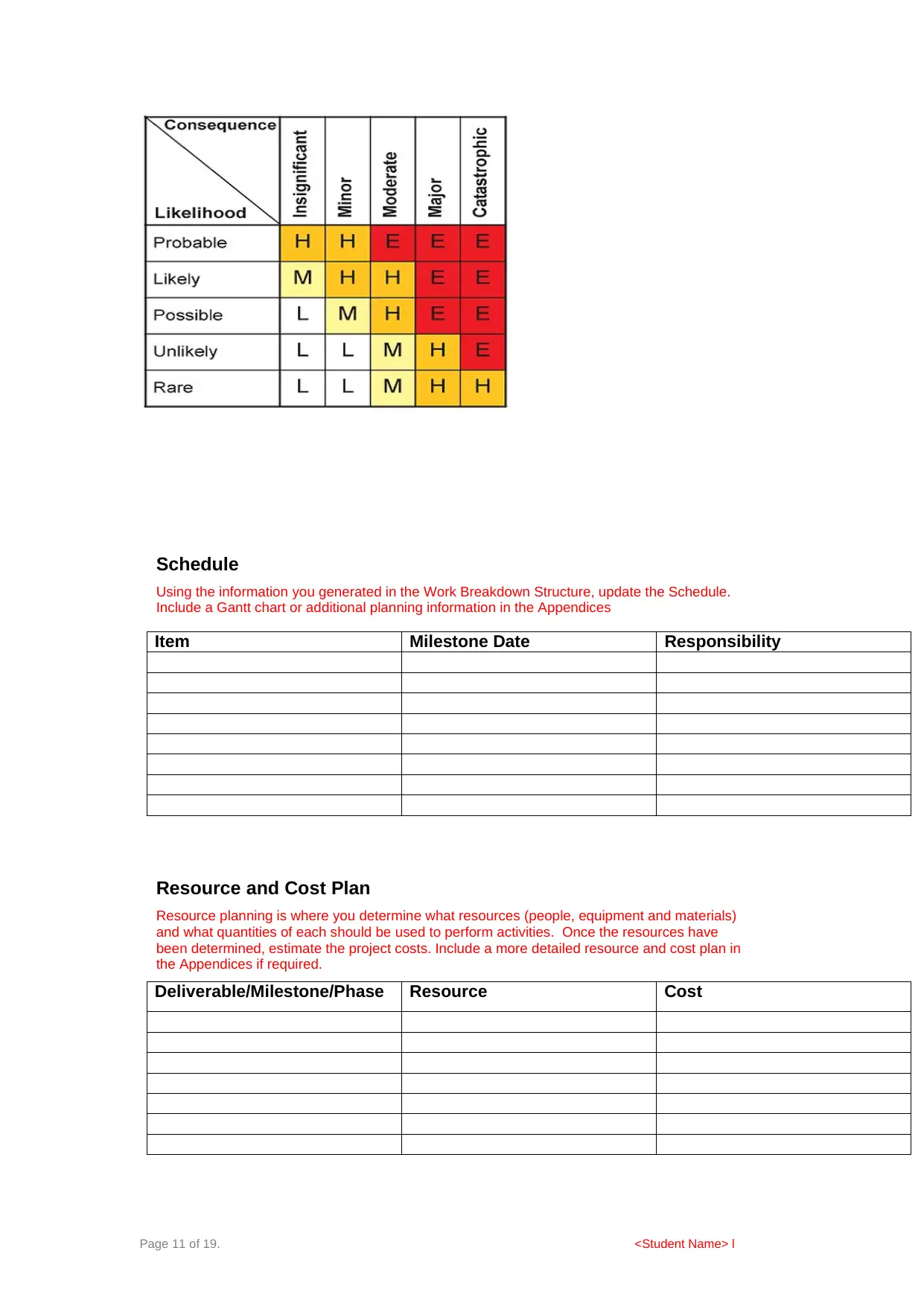
Schedule
Using the information you generated in the Work Breakdown Structure, update the Schedule.
Include a Gantt chart or additional planning information in the Appendices
Item Milestone Date Responsibility
Resource and Cost Plan
Resource planning is where you determine what resources (people, equipment and materials)
and what quantities of each should be used to perform activities. Once the resources have
been determined, estimate the project costs. Include a more detailed resource and cost plan in
the Appendices if required.
Deliverable/Milestone/Phase Resource Cost
Page 11 of 19. <Student Name> l
Using the information you generated in the Work Breakdown Structure, update the Schedule.
Include a Gantt chart or additional planning information in the Appendices
Item Milestone Date Responsibility
Resource and Cost Plan
Resource planning is where you determine what resources (people, equipment and materials)
and what quantities of each should be used to perform activities. Once the resources have
been determined, estimate the project costs. Include a more detailed resource and cost plan in
the Appendices if required.
Deliverable/Milestone/Phase Resource Cost
Page 11 of 19. <Student Name> l
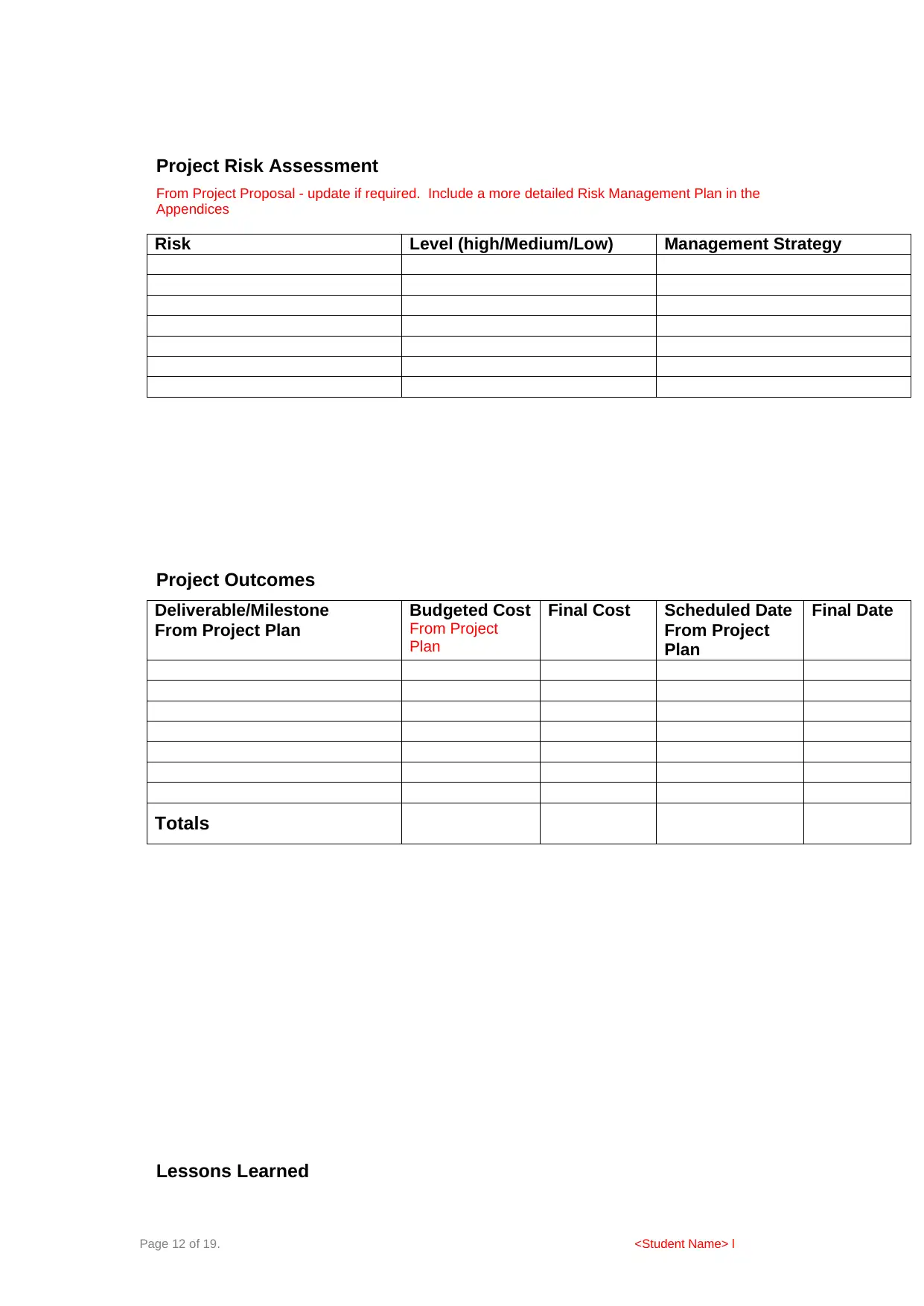
Project Risk Assessment
From Project Proposal - update if required. Include a more detailed Risk Management Plan in the
Appendices
Risk Level (high/Medium/Low) Management Strategy
Project Outcomes
Deliverable/Milestone
From Project Plan
Budgeted Cost
From Project
Plan
Final Cost Scheduled Date
From Project
Plan
Final Date
Totals
Lessons Learned
Page 12 of 19. <Student Name> l
From Project Proposal - update if required. Include a more detailed Risk Management Plan in the
Appendices
Risk Level (high/Medium/Low) Management Strategy
Project Outcomes
Deliverable/Milestone
From Project Plan
Budgeted Cost
From Project
Plan
Final Cost Scheduled Date
From Project
Plan
Final Date
Totals
Lessons Learned
Page 12 of 19. <Student Name> l
⊘ This is a preview!⊘
Do you want full access?
Subscribe today to unlock all pages.

Trusted by 1+ million students worldwide
1 out of 19
Related Documents
Your All-in-One AI-Powered Toolkit for Academic Success.
+13062052269
info@desklib.com
Available 24*7 on WhatsApp / Email
![[object Object]](/_next/static/media/star-bottom.7253800d.svg)
Unlock your academic potential
Copyright © 2020–2025 A2Z Services. All Rights Reserved. Developed and managed by ZUCOL.





